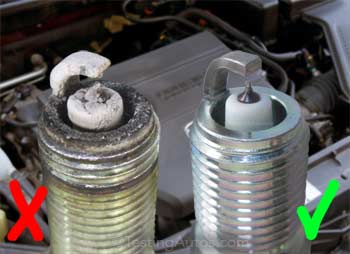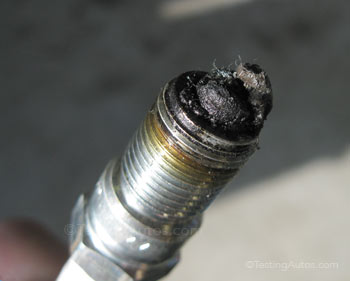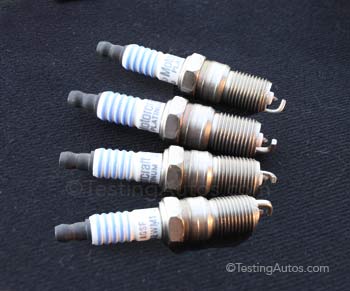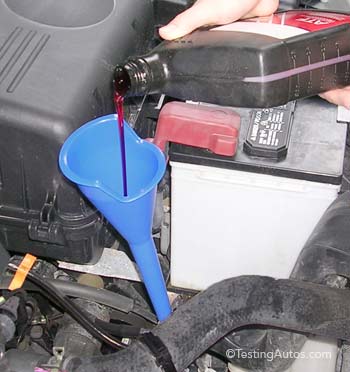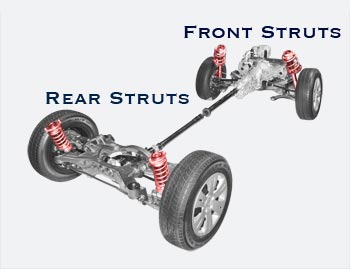When do spark plugs need to be replaced?
Updated: August 18, 2022
If your car starts well and runs smoothly, it means that you've maintained it well. It also means that the spark plugs in your engine are working. They ignite the air-fuel mixture in the cylinders; each cylinder has one spark plug.
Why do spark plugs need to be replaced? Over time they wear out, become contaminated and eventually fail.When should spark plugs be replaced? There are two types of spark plugs: conventional and long-life. Conventional spark plugs need to be replaced every 30,000-50,000 miles. Long-life (iridium- or platinum-tipped) spark plugs need to be changed between 60,000 and 150,000 miles, depending on the vehicle.
The recommended replacement intervals are posted in the Maintenance Schedule, which can be found in the owner's manual or in a separate Warranty and Maintenance brochure for your car. Spark plugs may also need to be changed earlier if there is a problem with them.
What are the signs that spark plugs are worn out?
In some cars, you might notice that the engine doesn't start as easily as before. It may run a little rough or hesitate when accelerating, especially when it's cold. Old, worn-out or contaminated spark plugs can cause poor gas mileage. Often, though, there are no symptoms until one of the old spark plugs stops working, causing the engine to misfire.The term "misfire" means that the affected cylinder is not firing up. For example, if one cylinder misfires in a 4-cylinder engine, it will run on only three cylinders. An engine that misfires runs rough, shakes and lacks power. The "Check Engine" warning light flashes on and off or stays on solid.
Should spark plugs be changed earlier as a precaution? It depends on the mileage. For example, if your car has long-life spark plugs that are due at 100,000 miles and your dealer recommends changing them at 50,000 miles, it's too early. If your engine is good on gas and runs like new, consider waiting until closer to the recommended mileage.
Can long-life spark plugs last past the recommended intervals? Yes, we have seen iridium spark plugs last longer, but at higher mileage old spark plugs are more likely to cause ignition coil failures. Long-life spark plugs have more durable electrodes, but they often fail because carbon deposits accumulate on the electrodes, as in the top photo.
Can the condition of the spark plugs be checked? Yes, spark plugs are typically inspected if the engine is misfiring, hesitating or not running properly. The condition of a spark plug can tell a lot to an experienced mechanic.
For example, if a spark plug is fouled with black oily deposits, it indicates presence of oil in the combustion chamber. This often happens when a car consumes oil between oil changes or when it's driven mostly for short trips, so the engine doesn't have a chance to fully warm up. If one spark plug is fouled while others look normal, it means that the problem exists only in that cylinder.
One of the symptoms of fouled up spark plugs is when the engine hesitates, sputters and runs rough at idle or when started cold, but clears out after revving or after driving on the highway. Fouled spark plugs must be replaced, but if the same problem returns, the problem with the engine must be corrected first.
If a spark plug shows signs of overheating or melting, it means that the cylinder is running hot, either due to a problem with the cooling system or overly lean air-fuel mixture or detonation. In a good engine, an old spark plug will show no overheating damage and will have a minimum amount of deposits; it can be of gray or tan color.
How much does it cost to replace spark plugs?
Conventional spark plugs are not very expensive ($6-10 per spark plug). Platinum or iridium spark plugs cost more ($15-40 each). Labor charges depend on the engine design. A repair shop may charge 0.8-1.2 hours of labor to replace spark plugs in a regular 4-cylinder engine, which is a fairly simple job. In some V6 engines, access might be difficult. For example, to change spark plugs in a Ford Edge or Escape with a V6 engine, the intake manifold will have to come off, bringing the labor cost to 1.5-2.5 hours.Do all spark plugs need to be replaced at the same time?
Yes, spark plugs are usually replaced as a set. It's important to use the correct parts, as wrong spark plugs may cause problems. It's also vital to carefully inspect new spark plugs before installation. If a new spark plug has been dropped on a hard floor, the insulator might be cracked. Cracks in the insulator are visible on close inspection, see this photo.Do all spark plugs need to be replaced if an ignition coil fails? If one of the ignition coils fails and spark plugs haven't been changed in a while, it's a good idea to change them all as a precaution. If spark plugs are fairly new, replacing one spark plug in the affected cylinder might be enough.
Advertisement
Do spark plug wires need to be replaced together with spark plugs? Yes, it's usually recommended. Old spark plug wires become brittle and tend to crack. Of course, many modern cars don't have spark plug wires.
Can spark plugs be cleaned? In old cars, it was a common maintenance job to clean spark plugs and adjust gaps between the electrodes. In modern cars, long-life spark plugs are not serviceable and are simply replaced.
How do spark plugs work?
There is one spark plug in each cylinder. Spark plugs are threaded into the cylinder head, so that the lower tip of the spark plug protrudes into the combustion chamber, see this photo.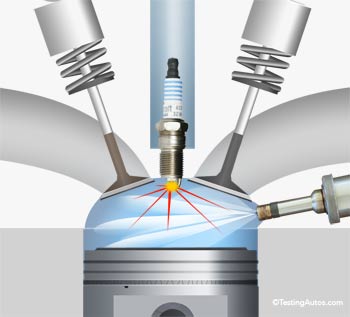 Spark plugs ignite the air-fuel mixture in the combustion chambers of the engine cylinders. See the 4-stroke animation.
Spark plugs ignite the air-fuel mixture in the combustion chambers of the engine cylinders. See the 4-stroke animation. In a four-stroke gasoline engine, during the compression stroke, the piston compresses the air-fuel mixture in a cylinder. As the piston approaches the top, the engine computer triggers the pre-energized ignition coil.
The ignition coil generates a high-voltage impulse that creates a spark between the center and L-shaped electrodes of the spark plug. The spark ignites the compressed air-fuel mixture, pushing the piston down; see the 4-stroke engine animation.
